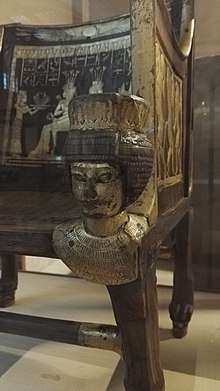Throne of Princess Sitamun
The Throne of Princess Sitamun is an artefact from the Tomb of Yuya and Thuya, which belonged to Princess Sitamun, the daughter of Pharaoh Amenhotep III of the 18th dynasty.
| Throne of Princess Sitamun | |
|---|---|
 The throne | |
| Material | wood, partially gilt and silvered |
| Size | height:78cm width:54cm depth:63cm. |
| Created | 18th dynasty, New Kingdom |
| Discovered | Tomb of Yuya and Thuya (KV46), Valley of the Kings. |
| Present location | Egyptian Museum |
| Identification | JE 5342; CG 51113 |

Description
The wooden throne is an example of the subtlety and elegance of Egyptian woodwork in the 18th Dynasty.[1] It is made from red wood, covered in parts by a 4 mm thick veneer of red wood. The legs are shaped like lion's paws. These paws sit atop high bases which are divided by ridges. The legs were originally covered in silver plate - some remains of which survive.
The front and rear legs are strengthened by bars under the seat. These bars are whole and were originally silver-plated too. The ends of these cross bars are gilt and shaped like stylised papyrus.
The very well preserved covering of the seat is made of finely woven material in a herringbone pattern. As is common for this period, the high back is inclined to the rear. The back is supported from behind by three vertical struts running in parallel. The two outer struts were supplemented with gilt wood edging. Armrests and seat frame were strengthened by gilt wood edging too and continued from the armrests up to the back of the chair. Gilt bronze nails supplement the wooden tenon joints.
At the front of the armrests there are gilt portrait heads. They are busts of princess, perhaps Sitamun herself. As is usual for this period, she wears a short, round, curly wig and a broad Usekh collar. Crown, face and collar are all gilt.
Backpiece
The backside of the chair's back is covered in silver and decorated with a fine feather pattern. The sides bear gilt decoration. On the front side there is a plaster relief depicting the winged sun above a scene which centres on the princess.
The scene is doubled, showing Sitamun enthroned before a young woman bringing gifts, twice. Her feet sit on a footstool or flat cushion. She wears a short curly wig and the typical sidelock of Egyptian royal youth, set off by a large earring. Her head is crowned by a gazelle diadem and topped by a tall lotus bloom. She wears a broad Usekh collar on her breast, as well as bracelets on her arms. In addition she has a tight-fitting garment of closely pleated linen, stretching down to her ankles. In her hands she holds a sistrum and menat - typical attributes of princesses and singers in the cult of Hathor. Both of the women bearing gifts are identical in appearance and costume, wearing half length wigs with an angular cut, headbands, foliage crowns, bracelets, earrings and usekh collars. They present a wide golden Usekh collar to the princess on a tray. This doubled scene is topped by a frieze of lotus blooms.
The image includes the titles and names of Sitamun and the presentation of the collar is captioned "Bringing in the gold of the southern countries."
Armrests
The inner sides of the armrests show a procession of four women bringing gifts, crowned with tall headdresses of lotus flowers which are shown alternately in side and top view. The women bear stacks of gold rings. Their ornaments and the shape of their long dresses vary from one another, otherwise their appearance mimicks that of the main scene on the back of the chair.
The outside of the right armrest shows the goddess Taweret with two figures of the god Bes. Taweret is depicted in the form of a hippopotamus with sagging breasts, a crocodile's back and a lion's paws. All figures have randomly dotted fur. One of the figures of Bes swings a knife, the other plays the tambourine. The left armrest shows Bes three times. The gods Taweret and Bes served as defense from evil forces, guaranteeing health and long life. Taweret was a goddess of fertility, pregnancy and birth. Both deities were regularly depicted on beds, headrests and chairs in the 18th dynasty.
Purpose
Given the wear of the gold leaf on the backrest, the moulding of the armrests and the ornamental portrait heads, it is thought that the chair was used on a day-to-day basis. But in addition it was also a piece of ceremonial furniture. The scenes depicting a gift of gold probably refer to the first Nehebkau festival of Amenhotep III.[2]
Bibliography
- Geoffrey Killen. Ancient Egyptian furniture / (Vol) I, 4000–1300 BC (Vol) II, Boxes, chests and footstools. Aris & Phillips, Warminster 1994., ISBN 0-85668-095-8, pp. 51–63.
- Marianne Eaton-Krauss. "Walter Segal’s Documentation of CG 51113, the Throne of Princess Sat-Amun." JEA. 75. 1989, pp. 77–88.
- Klaus-Peter Kuhlmann. "Der Thron im alten Ägypten. Untersuchungen zu Semantik, Ikonographie und Symbolik eines Herrschaftszeichens." ADAIK. 10, 1977, p. 88 with n. 5.
- Nicholas Reeves, Richard H. Wilkinson. The Complete Valley of the Kings. Tombs and Treasures of Egypt's Greatest Pharaohs. Thames & Hudson, 1996, ISBN 0-500-05080-5, p. 178.
- Dan Svarth. Egyptisk møbelkunst fra faraotiden. Skippershoved, Skårup 1998, ISBN 87-89224-39-6, pp. 64–85.
- André Wiese, Andreas Brodbeck, Andreas F. Voegelin, Andrea Maria Gnirs. Tutanchamun – Das goldene Jenseits. Grabschätze aus dem Tal der Könige. Hirmer, München 2004, ISBN 3-7774-2065-4, pp. 196–201.
References
- André Wiese, Tutanchamun. Das goldene Jenseits, p. 196.
- André Wiese, Tutanchamun. Das goldene Jenseits, pp. 196–201.